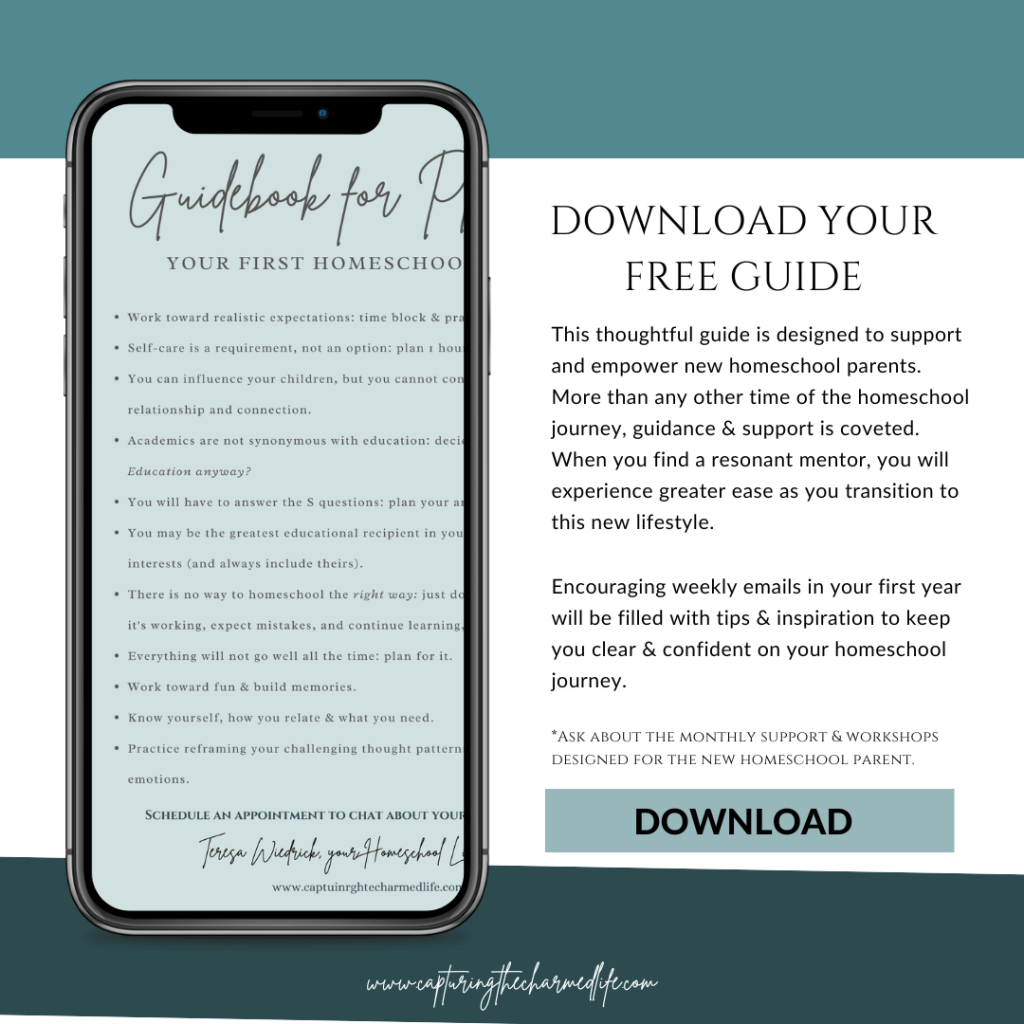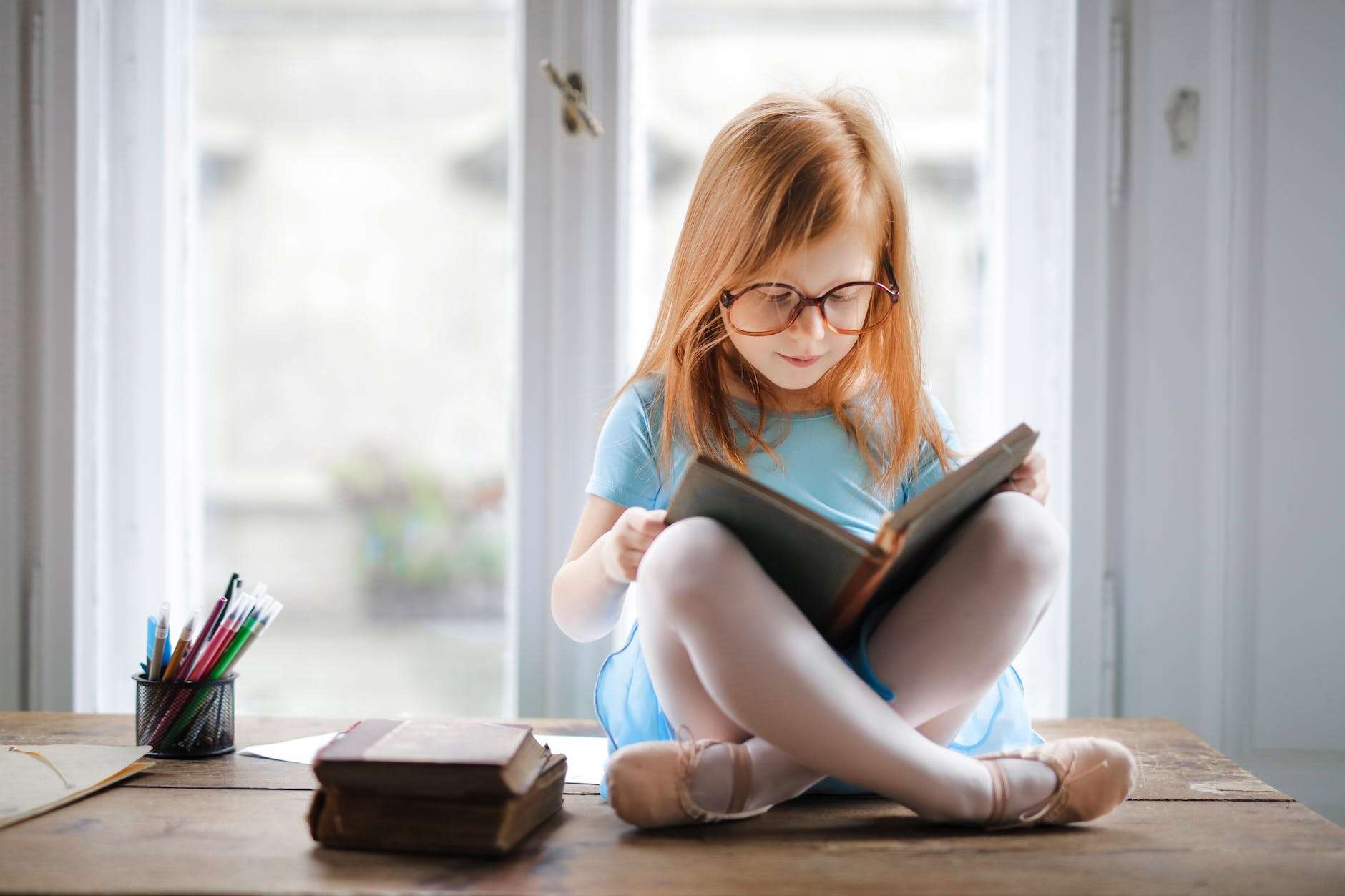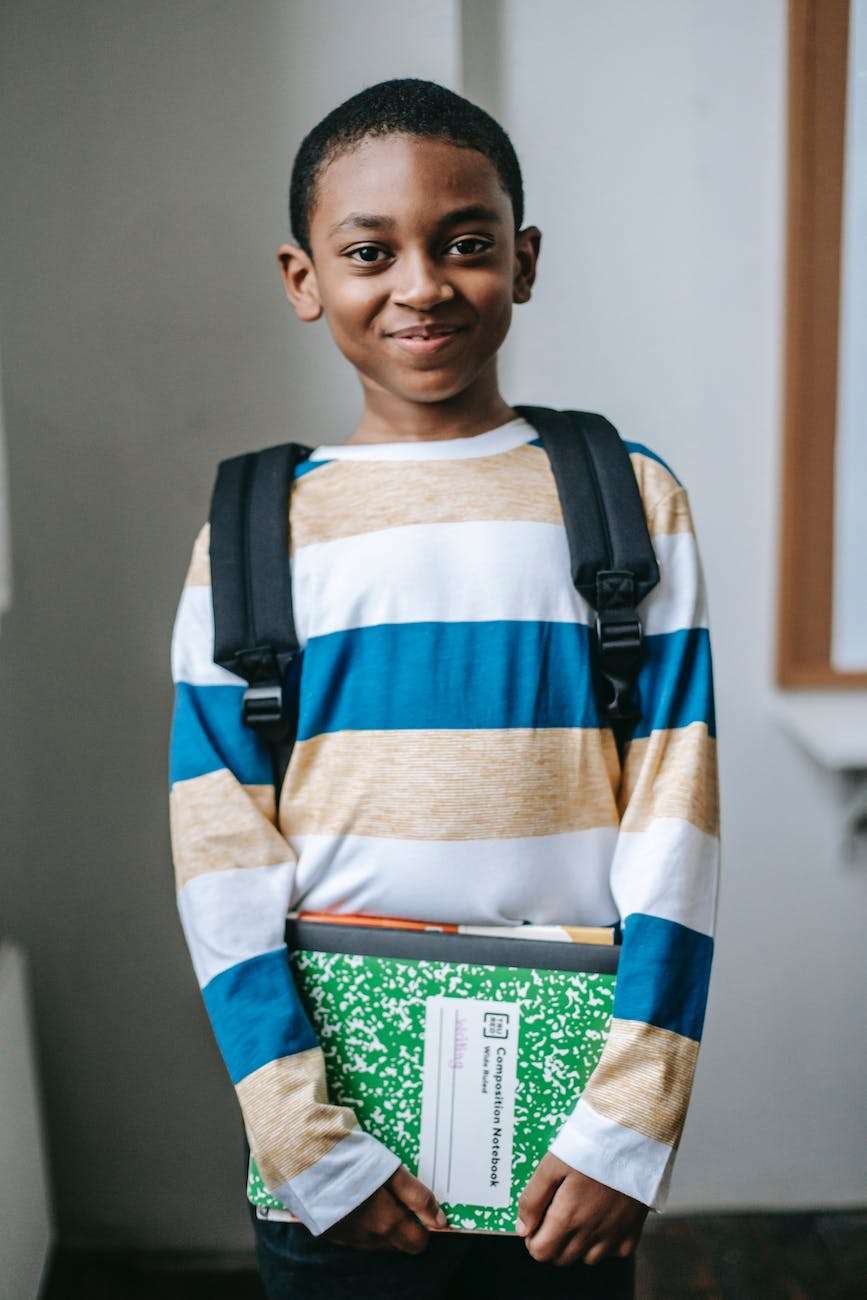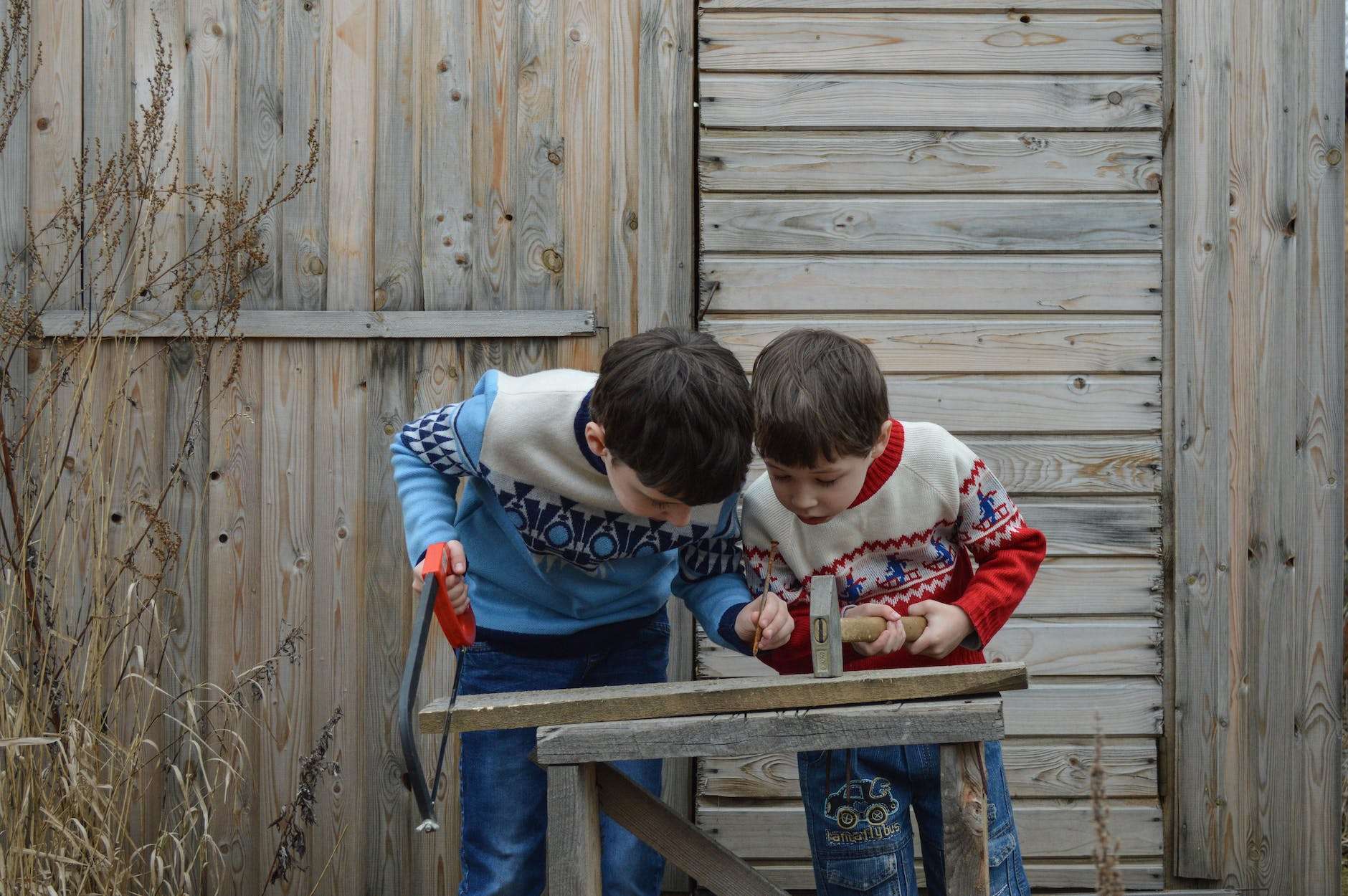Podcast: Play in new window | Download
This book, The Homeschooling Option: How to Decide When It’s Right for your Family, by Lisa Rivero, is the reason our family chose homeschooling.
I hadn’t even expected to purchase a book about homeschooling that day. We were on vacation at a nearby resort town (Canmore, Alberta, to be specific) with our three little girls. My husband released me from my mothering responsibilities as I wandered downtown with a coffee in one hand and nothing to do on my schedule.
Which naturally took me to the local bookshop. I love me a local bookshop. All those carefully chosen titles. A bookseller with heart. (Whoever owns a bookshop is an automatic kindred spirit).
A book on the homeschooling option? I didn’t have any intentions other than to peruse that day. To drag my fingers along the dusty shelves of differently-sized spines. To just look.
Then this book jumped out at me. Why did it jump out at me? All I can recall is that recently I had a conversation with another mom who was planning to homeschool. That seemed like a venture into insanity, not freedom if you had asked me then.
“I am beginning to suspect all elaborate and special systems of education. They seem to me to be built upon the supposition that every child is a kind of idiot who must be taught to think. Whereas if the child is left unto himself, he will think more and better, if less “showily”. Let him come and go freely, let him touch real things and combine his impressions for himself. Teaching fills the mind with artificial associations that must go rid of before the child can develop independent ideas out of actual experiences.”
Anne Sullivan, teacher of Helen Keller
You have a homeschooling option. Thank goodness, because there are limitations to the schooled experience:
A child’s intellectual capacity is not limited:
Children lack the ability to think for themselves and need to be taught how to think. This assumption is limiting as it underestimates a child’s curiosity and capacity for independent thought.
Einstein, the theoretical physicist, was quoted saying: “The only thing that interferes with my learning is my education” and “The important thing is not to stop questioning. Curiosity has its own reason for existing. One cannot help but be in awe when he contemplates the mysteries of eternity, of life, of the marvelous structure of reality. It is enough if one tries merely to comprehend a little of this mystery every day. Never lose a holy curiosity.”
For a kid who didn’t like school or appreciate it, here are a few concepts, theories, and ideas developed or advanced by Einstein during his lifetime:
- Theory of Relativity: Einstein’s 1905 paper on special relativity introduced the idea that the laws of physics are the same for all non-accelerating observers and led to the famous equation E=mc², which relates energy (E) to mass (m) and the speed of light (c).
- Theory of General Relativity: In 1915, Einstein formulated the theory of general relativity, which describes the gravitational force as the curvature of spacetime due to mass and energy. This theory provided a new understanding of gravity.
- Photoelectric Effect: Einstein’s work on the photoelectric effect in 1905 helped establish the concept of quantized energy in the form of photons, earning him the Nobel Prize in Physics in 1921.
- Brownian Motion: Einstein’s 1905 paper on Brownian motion explained the random motion of particles suspended in a fluid, providing evidence for the existence of atoms and molecules.
- Einstein Field Equations: These are the set of equations formulated by Einstein to describe the behavior of spacetime in the presence of matter and energy in the context of general relativity.
- Cosmological Constant: Einstein introduced the cosmological constant into his equations as a way to maintain a static universe, later referring to it as his “greatest blunder.” The concept has since played a role in modern cosmology.
- Einstein’s Mass-Energy Equivalence: E=mc² represents the equivalence of mass and energy, showing that mass can be converted into energy and vice versa.
- Theory of Critical Opalescence: Einstein developed a theory explaining why certain substances become cloudy near their critical points.
- Einstein-Rosen Bridge (Wormhole): In collaboration with physicist Nathan Rosen, Einstein proposed the concept of a bridge-like structure in spacetime, often referred to as a wormhole, which could theoretically connect distant points in the universe.
Now you should know that I couldn’t explain what any of these concepts were if it were not for the internet, because none of these are my interests.
- Quantum Theory of Light: Einstein contributed to the understanding of the quantum nature of light and introduced the concept of photons as discrete packets of energy.
- Theory of Specific Heat: Einstein developed a theory of specific heat in solids, which helped explain the temperature dependence of heat capacity.
- Theory of Brownian Ratchets: Einstein proposed a theoretical model for a “Brownian ratchet” device that could extract energy from random thermal motion, which has relevance in the field of nanotechnology.
- Unified Field Theory (Unsuccessful): Einstein dedicated much of his later life to the pursuit of a unified field theory, an attempt to unify the fundamental forces of nature. However, he was not able to complete this theory.
- Einstein’s Refrigerator (Patent): Although not widely known, Einstein and his former student Leo Szilard patented a refrigerator design in 1930 that used a non-toxic, nonflammable, and efficient cooling method.
- Influence on Modern Physics: Einstein’s work had a profound and lasting impact on the field of theoretical physics, including the development of quantum mechanics, and he played a crucial role in shaping our understanding of the universe.
The restrictive nature of traditional education:
Traditional education can be restrictive and overly structured, where kids tend to be confined within a fixed curriculum and teaching methods that may not align with a child’s learning style or interests. For example, when my daughter attended grade 1, she had a friend who was already reading Level 1 Readers.
Real-world experiences:
Experiential learning is where it’s at. Children learn best when they have the freedom to explore and interact with the real world, allowing them to form their own impressions and conclusions through hands-on experiences.
Artificial associations:
- Formal teaching creates “artificial associations” in a child’s mind. This can be interpreted as referring to the idea that traditional schooling may focus too much on rote memorization and abstract concepts rather than encouraging students to draw connections from their own lived experiences. Aka Goat Barn & Pythagorean theorem.
- Independent Thinking: Actual experiences can be more effective in nurturing their intellectual development. It implies that children have the capacity to develop their own ideas and problem-solving skills. For example, how my 14-year-old plays Bananagrams.
Is conventional wisdom that formal schooling is the best or only path to educating a child effectively? I shall answer with a question: Sure, your child can survive on fish sticks and goldfish crackers for his childhood, but does he have to?
“Being together all day, every day, forced us all to learn new and better ways to communicate and cooperate–valuable skills, but not always easy skills…Homeschool parents and children see each other at their best and their worst.”
Lisa Rivero, The Homeschooling Option
Choose the homeschooling option and you’ll quickly see why it’s necessary to embrace a growth mindset, so let go of perfectionism, and accept your moments of failure along the homeschool journey.
1. You’ll need to learn to communicate and cooperate.
There’s nothing easy about this one. In fact, there’s a whole lot of trial and error. Especially for you. And of course, for your kids, they’re new to the planet.
2. These are valuable skills, but they are not easy.
3. Accept imperfection & failure.
Embracing a growth mindset involves understanding that mistakes and setbacks are a natural part of the learning process. Perfectionism can hinder this process by setting unrealistic expectations. ps You won’t get to perfect, but the energy expended to try to be perfect is enormous.
4. Building a supportive learning environment.
Imagine what the detached learning environment might be like in school. Do you remember what that felt like when your teacher mistreated you? You didn’t have a chance to repair that wound with that teacher clarify what he or she meant or reconnect emotionally with that teacher. You weren’t close enough to your teacher to even let them know.
Our kids are that close to their parents. They have a chance for repair if possible. If you make that possible.
By embracing a growth mindset and accepting moments of failure, homeschooling can become a more supportive and nurturing learning environment. Children learn not to fear making mistakes and to approach challenges with curiosity and a willingness to learn.
We can even make learning about relating normal in our homeschool lives.
“One seldom discussed aspect and benefit of homeschooling is that it teaches parents a lot about themselves.”
Lisa Rivero, The Homeschooling Option
Oh, yeah, girlfriend. How do I love this homeschooling option? And how has it encouraged me in my personal growth? Let me count the ways.
You taught me that my voice can be too loud for my children to hear.
You taught me I need to assert my boundaries. In how I want to be spoken to. And how I want to speak to others.
That I can be misunderstood. Differently–by each of my kids.
You’ve taught me that I’m not naturally patient (but I might have known this one before I homeschooled).
You’ve taught me how to show up on time.
And you’ve taught me how to create margins in my day.
You’ve taught me that listening doesn’t mean parroting back what my kids say, but rather giving them eyeball-to-eyeball time, making their whole bodies feel heard.
You’ve taught me that all of my big emotions will be activated. And I need to know how to nurture them.
And you’ve taught me that I am more than a homeschool mom. I’m a person outside the homeschool mom role.
You’ve taught me that time is finite. I can’t do everything I want to do with my kids or by myself. And to accept my finiteness.
You’ve taught me that I will fail. Even repeatedly. But I can get back up again. Nurture my wounds. Learn something new. Ask for forgiveness. Clarify misunderstandings. Request that my feelings and needs be acknowledged. And honor and acknowledge the feelings and needs of others.
Oh, and you’ve taught me that homeschooling is more than just reading, writing, and arithmetic. It’s more than resources & extracurriculars. Or clever Instagram REELS.
Homeschooling is a lifestyle and environment where kids and parents can be nurtured. To grow up. And live their lives on purpose.

“I began to pay attention to the homeschooled teens we knew. They seemed unusually at ease in their own skins, confident about their abilities, and candid in their opinions. They had real conversations with their parents and with other adults. Their older siblings were going on to college after having homeschooled and reported no trouble with a transition to classroom education.”
Lisa Rivero, The Homeschooling Option
Every child is different; therefore, every child’s transition from homeschool to regular school is different.
Long before I considered homeschooling. I knew a family that had teens. Homeschooled teens.
The younger daughter worked or volunteered at the library, during her school days. She seemed quiet. But polite. Warm and engageable. I could have regular conversations with her. She was living in the real world.
I saw their family of four bicycling with their parents on a Saturday afternoon. I remember thinking how odd that was. Do teens hang out with their parents? I certainly didn’t when I was a teen.
Fast forward a whole bunch of years to my four teens. Some of my teens went on to public school in high school. One of them did not.
There is a very small number of homeschoolers in our area who homeschool high school. Almost everyone went to school in grade 10. And by the time my kids were in their high school years, their closest friends definitely went to the local high school.
Now, because I really like homeschooling (and 100% advocate for it for high school too), it was very difficult for me to release my oldest daughter to public high school. (It was less difficult with my third, and then fourth child, but I came to accept it). And I also came to understand that there was an element of consent or autonomy that I needed to honour in my teen’s individuating years.
But with the encouragement from a couple homeschool moms with older kids who did transition into public high school, and another mom who homeschooled then transitioned into regular high school, I was told this one thing: once a homeschooled kid, always a homeschool kid.
What I’ve noticed as my homeschool kids turned teenagers is that all of them, whether they were homeschooled in high school or public school was this:
They were accustomed to being heard. They were accustomed to having their needs acknowledged. Whether that be their physical needs in the middle of the day. They were accustomed to being seen as a separate person. A unique person. That had value and worth.
They weren’t accustomed to being a name on a student list. For a random adult to discover.
And they were accustomed to having regular conversations with humans across the age spectrum.
They were accustomed to socializing across the age spectrum.
And they assume they will be listened to by adults. When they knew they needed to graduate with a particular class that the school wasn’t making available to everyone, they stood outside the classroom.
Until the teacher finally allowed them. To join the class.
When they were introduced to multiple-choice tests. lThey had to have a quick overview of how to trust their gut, to read the question carefully. And not to second guess their answer. (Because multiple choice questions weren’t part of my homeschool.)
So when they transitioned to public high school, they discovered kids weren’t kind. And that the socialization thing that everyone had asked them about for so many years wouldn’t be all that useful to learn from.
Yet, whether public schooled or homeschooled in high school, they each, with their unique personalities, were more at ease in their own skins. More confident about their abilities. And candid in their opinions. Just as Lisa Rivero shared.
“The idea of teaching one’s children doesn’t really capture how homeschooling works, because it implies a formal tutoring relationship rather than a family experience. In essence, homeschooling is no different from teaching our children to wash the dishes, write thank-you notes, or drive a car. Parents are already their children’s teachers, and homeschooling parents continue in that role, just on a larger scale. Home education doesn’t require a radically different set of skills or knowledge base. Knowing how to teach a room of twenty-five students is very different from working with one’s own child, which we’d been doing all along. Also, as we will discuss in more detail in chapter six, homeschoolers teach themselves much of the time, and our job as parents is to facilitate, encourage, and support.”
Lisa Rivero, The Homeschooling Option
“The idea of teaching one’s children doesn’t really capture how homeschooling works. Because it implies a formal tutoring relationship rather than a family experience.”
In our early homeschool years, or before we begin homeschooling, we assume we need to learn how to teach our children.
We also assume that our children need a teacher to learn from.
We quickly discover that our children naturally learn because that is what they are hardwired to do.
They each have unique interests and they don’t follow the same rabbit trails. They may be interested in some of your rabbit trails and they may not.
One thing this homeschooling option is not is school at home.
“In essence, homeschooling is no different from teaching our children to wash the dishes, write thank you notes, or drive a car. Parents are already there. Children’s teachers and homeschooling parents continue in that role just on a larger scale.”
Because we live in a society that assumes there are places where someone might learn, like elementary schools, kindergartens, private schools, and post-secondary schools.
We therefore assume that learning can only happen through a delivery system that is structured. That has been overseen by administrators and by teachers.
What we forget as parents is that before our kids’ first preschool, kindergarten, or grade one class, we were already teaching them.
They were learning before someone taught them. Some of them taught themselves to read, add, and subtract. Also, some of them taught themselves to hop, skip & climb trees. Some of them learned to draw pretty pictures or dance like a ballerina.
Some of them asked why why why. About so many things. They were learning.
We showed them how to tie their shoes. Why are they especially challenged by this fine motor activity? Is it too early to show them how to do this? Is it too early, even when they’re asking for you to show them how?
Who is teaching your child to potty train? Who is teaching your child to sound out their first letters? Or print their name? Learn their colors? Or understand why the sky is blue? Or ask why the ants are all crawling in a line. It’s you, parent, that are teaching them.
You are teaching them before they enter the walls of the education system.
That teaching simply continues as you believe yourself to now have become homeschoolers. But really, you were teaching all along.
It’s the parent’s role to facilitate, encourage, and support. And the parent doesn’t have to homeschool 25 students (unless she’s also birthed them, adopted them, or fostered them).
And when you educate your specific child or five, remember that each of those children is uniquely and intricately known. By you.
Homeschooling is simply a continuation of learning.
“While a child in school has an occasional field trip outside the classroom, homeschooled children are in their communities nearly every day as they learn what is necessary to grow into the adult world. Homeschooled children learn from their parents, other family members, mentors in their neighborhoods, libraries, museums, the Internet, community classes, and each other, much as children have learned throughout the centuries.”
Lisa Rivero, The Homeschooling Option
Can children only learn in a classroom with a teacher? Grades. Tests and textbooks.
As parents overseeing our kids’ education we learn that they learn everywhere they go. They learn in the backyard as they’re building mud patties that they shape with twigs and branches in hopes that the birds will use them for their nests.
They learn when they climb up a tree at a playground.
And they learn about international news because they listen to a radio news show through their Alexa.
Learning takes place in the goat coral when they are trying to build a functional goat barn, and the Pythagorean theorem would help them make a functional goat barn.
In the dance studio, toning their core, by doing regular AB workouts, will make it easier to make smooth ballet turns.
When they go to college in a city that is bilingual, they learn how to speak French, and quickly, because they will have to write final college exams in French.
They learn everywhere they go. And they learn because that’s what kids do. They learn.
When we bring them along to our activities, whether that’s heading to the post office or grocery store again. Or a trip to rural Africa where they’re assisting dad on male surgical rounds or pediatric rounds at the pediatric malarial unit. Children learn.
They don’t need the four walls of an institution to learn.
Also, they don’t need an institutional prescription to learn. They don’t need your permission to learn.
Homeschool kids definitely learn from the adult world because they live alongside adults living in the real world: this is the homeschooling option.
“John Holt wrote in How Children Learn, “All I am saying in this book can be summed up in two words: Trust Children. Nothing could be more simple, or more difficult.” Trust in the child’s ability to learn is the bedrock of Holt’s views on homeschooling, and he introduced the term “unschooling” to describe this kind of natural learning that happens outside schools. Holt argued that all of us have an innate desire and need to learn, not just as children, but for our entire lives. Schools tend to interfere with this innate drive with artificial expectations, evaluations, and a template of what education should be for everyone at a certain age. Families who follow Holt’s ideas don’t worry much about learning specific subjects at specific ages or covering all aspects of math or science. Instead, they trust that when a child discovers the need to learn, he or she will find a way to learn, or will ask for guidance from a parent or other adult.”
Lisa Rivero, The Homeschooling Option
Perhaps it’s because formal educational systems exist and perhaps because prescription parenting books exist, that parents assume that if they follow the system and the advice, parents will produce the perfect product of a child.
Society doesn’t assume we can go to our children, to learn from them, and learn how they need to learn.
We are told children are blank slates before they enter this world. Therefore, we need to upload content to their blank slates.
We are told and we believe that children need to be taught how to learn. That they don’t have an innate desire.
I’m with John Holt in this quote for two reasons.
One, I’ve come to understand that for a child to genuinely engage in their life fully, they need to want to.
Secondly, it’s really hard as a parent to let go and lean into trusting your child’s ability to learn. To allow for natural learning.
I believe our culture assumes that a teenager is bored because he is disinterested in life and more engaged with their devices than they should be.
However, I believe that teenagers have had systematic stamping out of internal motivation.
If we were to interfere less with how they need to learn, or what they need to learn, or in what way they need to learn, or how their learning was evaluated, in the contrived manner that we presently are doing, we would have much more engaged humans as they entered the independent adult stage of their lives.
Our entire culture would benefit because we would have energized creative humans. Eager to create. They’d be curious. And would engage their world when they were 12, 22, 42, or 72.
The world would be a tapestry of interesting things.
Each person would be uniquely recognized. Their unique value and offering to the world would have a much deeper meaning to them; therefore, each person would have a deeper sense of purpose in why they’re here.
They’d be living their lives on purpose.
I hardly think that I or any others who see the world as I do are going to easily reform our approach to children’s learning. I personally don’t have the heart to attempt a conventional school reformation.
However, I do want to bolster you and your passion and your confidence in recognizing that your children learn, because they are children. Therefore, you can trust your children.
You can follow their curiosities, aptitudes, and interests and help them develop into the humans they were meant to be on planet Earth. And you can do this for yourself too.
Whether you understand that homeschooling is a whole lot more than doing school at home, if you identify with many of the things I’ve shared in this episode, I wish for you to feel free to enable their innate drive to learn, with or without evaluations, or a standardized education, with or without diplomas and degrees, so they can (& you) can live their lives on purpose.
As much as you’re able, work at getting out of their way. Trust them. So they can learn.
If you’re a new family contemplating the homeschooling option, “The Homeschooling Option: How to Decide When It’s Right for your Family” by Lisa Rivero provides invaluable insights into the world of homeschooling.
As you’ve seen, homeschooling isn’t just about replicating traditional schooling at home; it’s a journey of discovery, growth, and empowerment for both parents and children.
For seasoned homeschooling families, this book offers a chance to reaffirm your commitment to this remarkable path. Lisa Rivero’s words remind us that homeschooling isn’t just an alternative to conventional education; it’s a lifestyle that fosters independent thinking, encourages real-world experiences, and allows children to learn at their own pace.
Homeschooling isn’t always easy, but it’s an incredible opportunity to build strong family bonds, nurture curiosity, and create a customized educational experience for your children. So, whether you’re new to homeschooling or have been on this journey for years, “The Homeschooling Option” encourages you to trust in your children’s innate desire to learn and continue living your lives on purpose.
Take the homeschooling option, and embark on a unique educational adventure that empowers both you and your children to thrive in a world full of possibilities.

Reimagine your Homeschool Workbook
Introducing the Reimagine Your Homeschool Workbook! Reflect on the past year, assess what worked and what didn’t, and build the homeschool you truly want. Evaluate curriculum, routine, philosophy, and plan for the future. Get renewed inspiration and fresh ideas.
People also ask:
- Encouragement for New Homeschoolers
- Dive into 10 Helpful Books for Homeschooling Moms!
- Empowering Newbies: Homeschool Mama Self-Care Podcast
- Get Started Homeschooling: 1st Year Guide to a Successful (& Satisfying) Homeschool
- What Does Homeschool Cost: 13 Things I Wish I Knew
- Join the 1st Year Homeschool Mama Support Group







